
views
X
Expert Source
Kaveri Karhade, MDBoard Certified Dermatologist
Expert Interview. 5 January 2021.
However, if it bothers you, it doesn't have to be a permanent issue. There are a variety of effective, lasting ways to address it. By safely lightening these regions, your skin can have a beautiful, even tone in the bikini areas once again.
- Try an easy DIY method. Rubbing milk, peroxide, or almond paste on your inner thighs can remove dark patches.
- A dermatologist can offer you laser hair removal or bleach treatments to solve your problem.
- Prevent future dark spots by purchasing an effective razor, wearing sunblock, and altering your diet. The more veggies and water you consume, the better.
Lightening the Bikini Areas with Home Remedies

Use Papaya Soap. Papaya soap is natural and using it regularly will help to lighten the skin. Use it at least twice a day, once in the morning and once at night, until you see results. Keep your skin moisturized because it can dry out your skin. You can also mash up a chunk of ripe papaya, and apply a big dollop on the areas. Leave it on for 30 minutes and then wash it off. In a couple of week's time, you should see significant lightening.
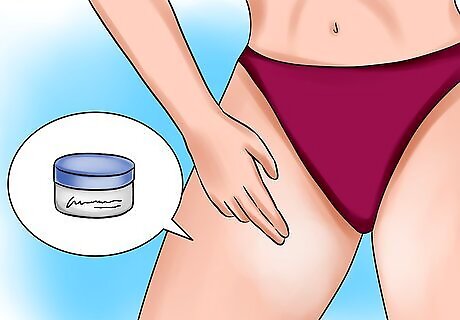
Apply glycolic or salicylic acid acne pads. These two ingredients are the lightening agents used for acne treatments and can also be used for this purpose. Dab a pad on the areas and then get into the shower. Let the steam sink in for a couple minutes and wash off. Don't do this treatment immediately after shaving, however, as it could irritate it.
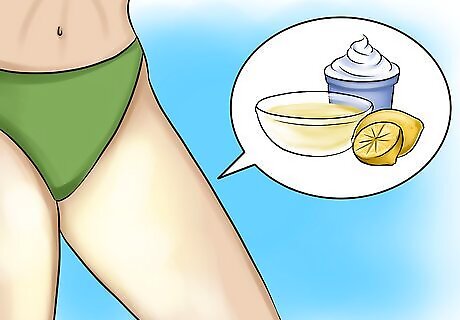
Use a lemon juice, yogurt mix. Mix juice from 1/4 lemon into a tablespoon of yogurt, and apply to the area. It acts as a mild bleaching solution that will safely lighten it. Apply aloe vera gel afterwards to keep your skin moist and hydrated. Don't do this treatment immediately after shaving, however, as it could irritate it.
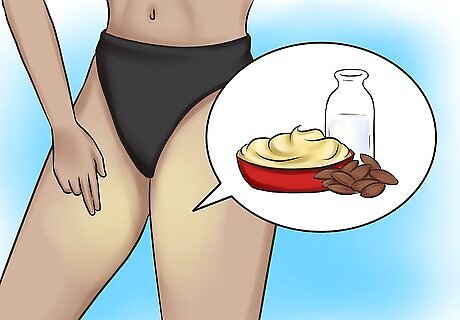
Apply almond paste. Soak several almonds for 24 hours. Then slide the skins off, and add a couple drops of milk to make a paste. Put on the bikini areas, and leave on for an hour. Wash off with warm water. If used regularly, it works as a mild lightener and also exfoliates and softens the skin.
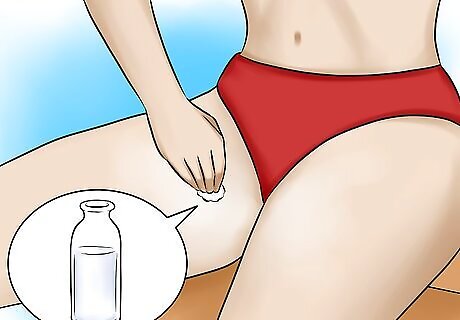
Try using milk to lighten and moisturize your skin. Pour some milk into a bowl and dip into with a cotton ball. Dab onto your skin. Milk is a natural skin lightener, and it also won't dry it out. It's not going to happen overnight but with regular use, you will see some slight results.
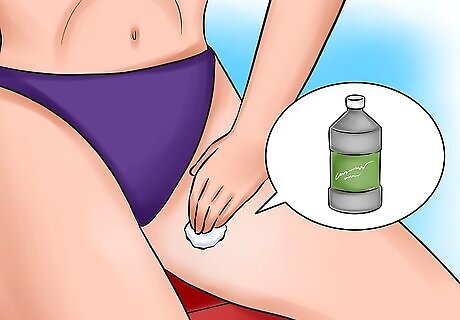
Apply peroxide onto the area. Wipe off after 15 minutes. Do this a couple of times a day until you see results. Peroxide is highly acidic, so you may want to apply a little almond or coconut oil on the area after washing it off. Don't do this treatment immediately after shaving, however, as it could irritate it.
Going to a Dermatologist to Correct the Problem

Ask the doctor about using a skin bleaching cream containing hydroquinone. This kind of cream works by preventing melanin from being produced in the skin. It's one of the most popular lightening treatments. However, if the concentration is too high or if it's used for too long, it could worsen the discoloration or reverse the effects. It can also be toxic to the liver.

Talk to your dermatologist about a milder skin bleaching treatment. Some alternative, fading creams that are known to have less side effects are azelaic acid, kojic acid and one containing only 2 percent hydroquinone. All of these are known to help with persistent or residual skin discoloration problems. They work by preventing keratin, a hair protein, from being produced in the skin. These creams should only be used under the direction of your dermatologist.

Find out from your doctor if you're a good candidate for using a bleaching agent, such as chlorine, to lighten the areas. This is a mix formulated by the medical professional doing the treatment. Due to the concentration of bleach, dermatologists and medical doctors are the only ones allowed to administer it.
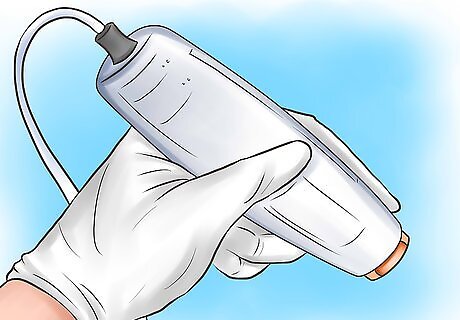
Opt for laser hair removal. If the darkening is caused by waxing, shaving, and/or you can see dark hair stubble as it's growing back, then laser hair removal may be a good solution for you. Though it's considered semi-permanent, the hair usually doesn't come back. However, you have to make sure to complete the recommended number of treatments and the ongoing, but infrequent, touch-ups.
Preventing Darkening of the Bikini Areas
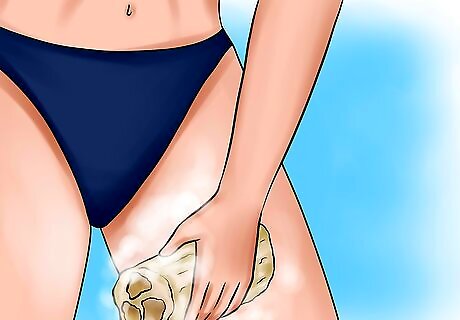
Exfoliate the area. Old skin cells don't just build up on your knees and elbows but on other areas of the skin as well. When they accumulate, they can make the skin appear darker and duller. Prior to shaving, lightly exfoliate the region using a loofah, scrub or exfoliating brush. This will remove the dry skin and will also help to prevent skin irritation and ingrown hairs in the bikini areas.
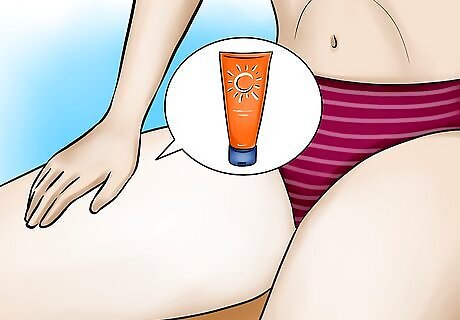
Use sunblock. When going in the sun, use a sunblock to keep the sun from penetrating those areas of your skin that you don't want getting darker. Choose a sunblock with a high SPF number (Sun Protection Factor) such as SPF 45 on that region. Also when you come out of the sun, apply olive oil to the area, as it's also known to be a natural skin lightener.

Wear breathable, cotton clothing that is loose and comfortable. Sweating in the bikini areas are known to cause darkening. Avoid polyester clothing and other synthetic fabrics, as they don't allow the skin to breathe. Also tight clothing sometimes causes chafing and could also darken these areas.
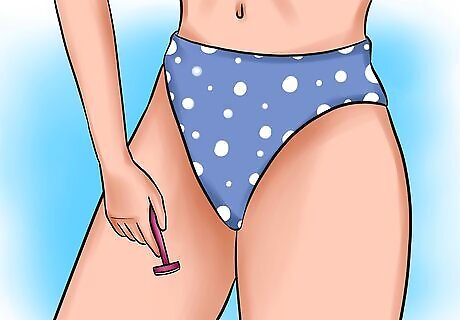
Use a quality razor, and shave gently in the direction of the hair growth. If shaving irritates the skin, it could darken it. Basically, dark spots are caused by constant friction. If you shave every day, your skin attempts to protect it so it darkens up. Any type of injury to your skin will either create a stain or keloid. Waxing can also cause darkening if it's too hot.

Eat more vegetables and fruits. Fruits, oranges and berries, in particular, and green, leafy vegetables have lots of antioxidants that assist in reducing discoloration of the skin. Drinking water also helps to flush toxins out of the body.
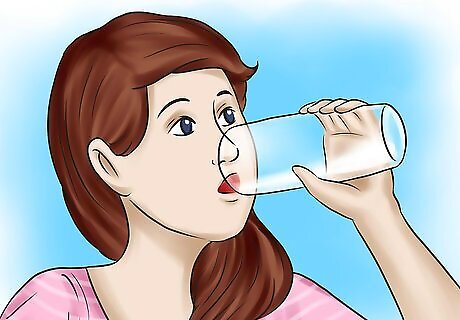
Drink more water. It is one of the best ways to detoxify. There is no one-size-fits-all to how much water a person should drink. As a general rule, though, women should drink 128 ounces a day, and men should consume 128 ounces of water a day.

















Comments
0 comment